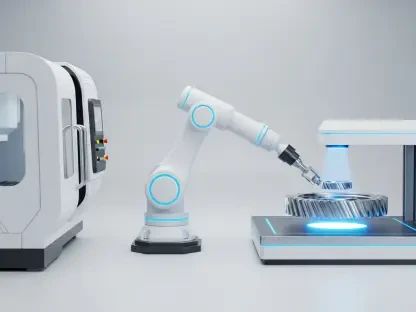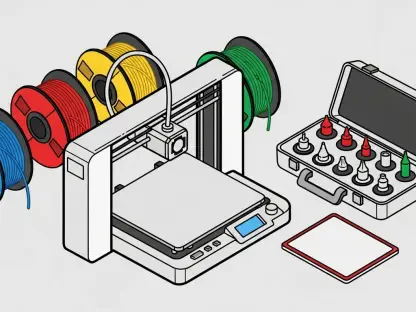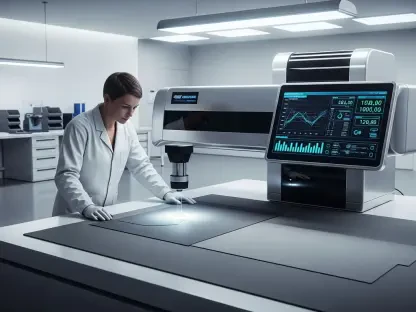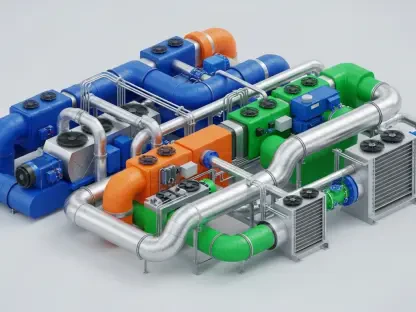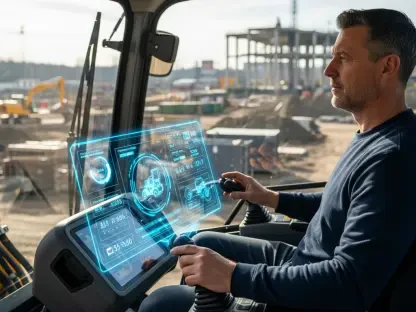In the heart of the industrial landscape, the United States stands at a pivotal juncture, poised to reclaim its role as a dominant force in global manufacturing through the powerful integration of artificial intelligence (AI) and innovative strategies. As traditional manufacturing practices have struggled to sustain growth and competitiveness, the introduction of advanced technologies such as AI presents unprecedented opportunities for transformation. The narrative of revitalizing U.S. manufacturing is shaped by the quest to redefine existing paradigms, address looming employment challenges, and capitalize on the country’s inherent strengths. Central to this endeavor is the concept of shadow factories—an innovative approach that seeks to unlock dormant production capacities. By implementing AI and leveraging untapped resources, the United States is endeavoring to distance itself from other manufacturing giants like China, translate the benefits into high-paying jobs, and ultimately achieve far-reaching economic prosperity.
Navigating Workforce Challenges and Economic Potential
Since the decline of the manufacturing workforce began in 1979, nearly a third of the industry’s jobs have vanished, leaving a significant void in this essential economic sector. This workforce contraction presents a critical challenge: the task of recruiting and training a new generation of skilled workers to fill the gap left by the aging workforce. With 2.8 million workers nearing retirement over the next few years, the U.S. manufacturing industry faces a potential shortfall of nearly two million workers if proactive measures aren’t taken. Despite this daunting scenario, U.S. manufacturing maintains its significance with a formidable $2 trillion industry and a notable economic multiplier effect, where every dollar spent generates nearly three dollars in additional economic impact. This demonstrates the sector’s potential, underscoring the need for strategic initiatives that ensure continued growth and competitiveness.
Addressing the workforce challenge requires innovative solutions, starting with comprehensive training programs that align with the evolving technological landscape. These programs should focus on equipping workers with the skills necessary to operate advanced manufacturing technologies. Additionally, such initiatives must be inclusive, encouraging a diverse talent pool to participate in these modern industrial roles. By fostering a technically skilled workforce, the U.S. can harness existing strengths, including its reputation for innovation and technological prowess, to bolster its global manufacturing standing. The country’s future as a manufacturing powerhouse hinges on embracing this dual strategy of workforce revitalization and economic exploitation, converting challenges into opportunities for national and global economic gain.
Embedding AI and Automation in Industry Practices
The potential for U.S. manufacturing resurgence is closely tied to its ability to adopt AI and automation as central elements of industrial practice. These technologies extend beyond mere tools; they represent the foundation for scaling modern manufacturing capabilities. AI can revolutionize manufacturing by enhancing efficiency, reducing costs, and improving product quality through predictive analytics and machine learning. Automation further complements these efforts, streamlining operations and minimizing human error. Together, AI and automation present a formidable duo capable of transforming traditional production models into flexible and adaptive manufacturing systems.
To fully capitalize on AI and automation, industries must prioritize integrating these technologies across all levels of their operations. This involves strategic investments in digital infrastructure, the development of AI-driven tools accessible to workers at all skill levels, and the cultivation of a culture that embraces technological innovation. The effectiveness of these efforts is exemplified by companies that have already seen tangible benefits through AI implementation, such as improved equipment utilization and reduced downtime. By unlocking latent production capabilities, AI can enhance overall productivity without requiring substantial new capital investments, thereby positioning U.S. manufacturing to compete on a global scale.
Unlocking Shadow Factories and Enhancing Productivity
A transformative concept at the forefront of U.S. manufacturing revitalization is the idea of shadow factories. These represent the nation’s existing but underutilized manufacturing capacities, hidden within current operations and constrained by operational inefficiencies. By deploying AI to address these issues, manufacturers can enhance productivity through optimization of existing resources. For instance, applying AI-driven predictive maintenance reduces downtime, leading to significant improvements in equipment effectiveness. Such advancements mirror the construction of new facilities without the associated costs, marking a shift toward maximizing existing assets for heightened national manufacturing output.
The potential savings and productivity gains offered by shadow factories exemplify a modern approach to manufacturing that prioritizes efficiency and sustainability. Take, for example, a cement manufacturer who successfully increased overall equipment effectiveness by 4% using AI, equivalent to the productivity of two new cement plants. By focusing on mitigating productivity loss through intelligent use of resources, major manufacturers can gain additional production capacities equivalent to constructing new facilities—all without expanding their physical footprint. Shadow factories thus highlight a sustainable path forward, ensuring that the industry can adapt and thrive amid evolving global economic pressures.
Building a Future-Ready Workforce and Public Perception
While the benefits of new manufacturing paradigms powered by AI and advanced technology are becoming more evident, an equally important task lies in redefining public perception and developing a workforce ready to embrace these changes. Public sentiment toward manufacturing remains complex; though many recognize the industry’s potential benefits, fewer view it as a desirable career path. Addressing this perception issue requires the promotion of manufacturing as a hub of innovation and opportunity, appealing to new generations of workers by emphasizing roles steeped in high-tech environments and driven by sophisticated technologies like augmented reality and smart manufacturing systems.
Developing such a future-ready workforce necessitates robust, government-sponsored training programs focused on bridging existing skills gaps with the new demands of advanced manufacturing. These training initiatives must target diverse talent, incorporating varied perspectives and abilities, to ensure comprehensive engagement of potential job seekers. Transforming public narratives around manufacturing careers will play an essential role in attracting talent to the sector, paving the way for the United States to establish itself as a leading figure in cutting-edge manufacturing. By presenting modern manufacturing as a vibrant and essential frontier of technological advancement, the nation can inspire widespread interest and investment in these evolving opportunities.
Strategic Policy and Long-Term Investment
The successful revival of U.S. manufacturing hinges not only on technological integration but also on implementing strategic policies that promote sustained growth and innovation. To provide clarity and stability for manufacturers, government authorities must craft and enforce policies that support long-term investments, ensuring a streamlined path for businesses entering or expanding within the manufacturing arena. Such policies would foster a secure environment, permitting manufacturers to anticipate reliable returns on their investments.
Equally crucial is the need for policies that reinforce sustainable growth, including regulatory clarity and incentives that encourage businesses to innovate and optimize resource utilization. These measures also entail addressing key issues such as regulatory consistency, supporting environmental sustainability, and spearheading public-private partnerships that stimulate technological development. Crafting policies conducive to manufacturing growth will ensure the industry can adapt to changing global circumstances, unleashing its potential as a linchpin of economic innovation.
Envisioning a Reimagined U.S. Manufacturing Sector
In the core of its industrial framework, the United States is poised at a crucial point, ready to reclaim its dominant position in the global manufacturing arena through the strategic use of artificial intelligence (AI) and forward-thinking strategies. Traditional manufacturing practices have faltered in sustaining growth and remaining competitive, necessitating a shift towards advanced technologies like AI, which offer transformative possibilities. The narrative around reviving U.S. manufacturing is driven by a need to redefine old paradigms, tackle impending employment challenges, and harness the nation’s intrinsic strengths. A crucial element in this strategy is the concept of shadow factories—an innovative method that seeks to activate unused production capabilities. By embedding AI and tapping into these latent resources, the U.S. aims to separate itself from other manufacturing leaders such as China, turn these advantages into high-paying jobs, and secure widespread economic prosperity. This approach reflects a new era for American industry.



